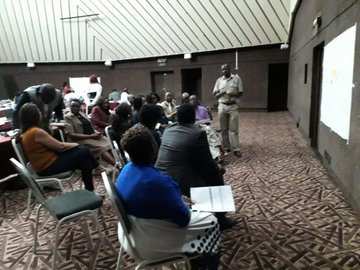The Food and Agriculture Organization of the United Nations (FAO) is leading the process to design and formulate a project document under the Global Environment Facility 7; “The Dryland Sustainable Landscape Impact Program”.
On 18 October 2018, the GEF Secretariat selected FAO as GEF lead agency for this Sustainable Forest Management Impact Programme (Dryland Sustainable Landscapes (SFM DSL). FAO was chosen as lead agency based on its mandate and comparative advantage, covering all the required fields of expertise to deliver the Impact Program in an integrated manner.
The DSL will be implemented in 11 countries in Asia and Africa. For Africa, the Miombo and Mopane dry-land ecosystems will form the core of the programme, and will therefore include 6 countries (Angola, Botswana, Namibia, Tanzania, Malawi and Zimbabwe). The participating countries from the two regions were selected by the GEF Secretariat based on an independent review of expression of interests that were submitted by eligible countries that are located in drylands. The selected countries will benefit from an incentive mechanism, a global set aside, which will contribute to reach the anticipated impact across boundaries.
Speaking at the workshop held at the Monomotapa Hotel in Harare on 17 September 2019, Mr. Munesu Monodawafa, the Permanent Secretary for Environment, Tourism and Hospitality Industry said the the meeting was aimed at informing national stakeholders on the project approach; main interventions and expected results; to refine and validate project areas; and to identify all relevant stakeholders in the targeted landscapes.
“The DSL IP is expected to provide significant support to the country to avoid further degradation, desertification, and deforestation of land and ecosystems through the sustainable management of production landscapes, addressing the complex nexus of local livelihoods, land degradation, climate change, biodiversity conservation and sustainable use as well as environmental security,” Mr. Munodawafa said.
He said for Zimbabwe, the GEF has been and still remains the largest partner for environmental management. The country has implemented about 43 projects since joining the GEF in 1994. For the 7th GEF Cycle (2018-2022), Zimbabwe was allocated US$9, 25 million, part of which will be used in the SFM DSL project.
“The funding from GEF is addressing many institutional gaps in the management of key ecosystems to achieve global environmental benefits. This is critical as Zimbabwe is home to key ecosystems of international significance such as Biosphere Reserve, National Parks, World Heritage Sites, Ramsar Sites and Key Bird Areas. Management of such complex ecosystems require huge financial resources and planning.
“As a country we will play our part to ensure that GEF financing produces results. Zimbabwe commits to ensuring the achievement of global environmental benefits. We will endeavour to avoid irreversible environmental damage, maintaining essential environmental processes and preserve the broad spectrum of biological diversity for current and future generations,” Mr. Munodawafa added.
The Impact Program is expected to contribute in addressing the scientific consensus that the natural world is under attack. The recent report from the Intergovernmental Science-Policy Platform on Biodiversity and Ecosystem Services (IPBES) released in May 2019 states that one million species around the world are under threat of extinction as a result of human activities.
The report further states that biodiversity and the services they provide are essential to human existence and good quality of life and to the achievement of the SDGs. The report also makes clear that the major causes of this global degradation of nature are related to how humans use land and freshwater resources, specifically agriculture and food production and the related supply chains.
FAO Zimbabwe Assistant Representative, David Mfote said the unsustainable land use and the resulting deforestation and loss of natural habitats is also a significant contributor to greenhouse gas (GHG) emissions and to climate change, which through feedback loops further exacerbates the negative trends of the loss of biodiversity.
“One of the main conclusions of the report is that: “Goals for conserving and sustainably using nature may only be achieved through transformative changes across economic, social, political, and technological factors”. The GEF 2020 strategy adopted by the Council in 2014 promotes the driver focus and systems transformation. To achieve these goals, it suggests the GEF employ integrated approach and multi-stakeholder partnership.
“The DSL is expected to provide support to countries to avoid further degradation, desertification, and deforestation of land and ecosystems through the sustainable management of production landscapes, addressing the complex nexus of local livelihoods, land degradation, climate change, biodiversity conservation and sustainable use as well as environmental security,” Mfote said.
He said that the the Project objective is therefore: “To halt and reverse negative trends of land and forest degradation and enhance climate resilience of degraded areas of Miombo and Mopane woodlands in the Save and Runde Catchments by applying holistic and integrated land and forest management approaches in support of Land Degradation Neutrality (LDN).
The Project implementation will be led by the Ministry of Environment, Tourism and Hospitality Industries, with technical support from FAO, who in turn will act as the GEF Implementing Agency. The ministry will implement the project in close collaboration with Ministry of Agriculture, Lands, Climate, Water and Rural Resettlement; Forestry Commission; Environmental Management Agency, and National Parks and Wildlife. Project execution and implementation arrangements will be defined in order to facilitate the drafting of the relevant section of the project document by the formulation team. During the preparation of the full project document, the project components will be designed in a comprehensive manner.
